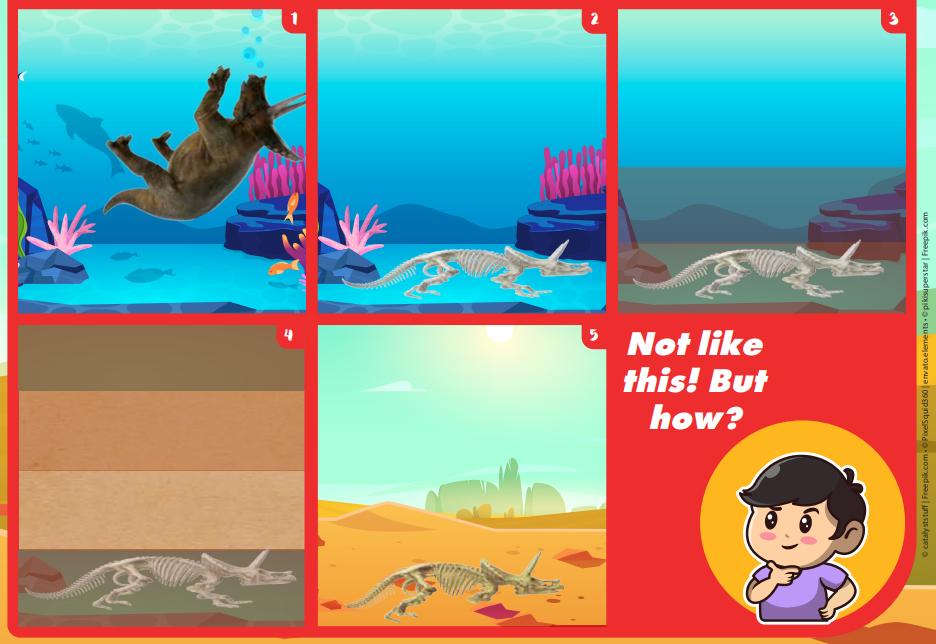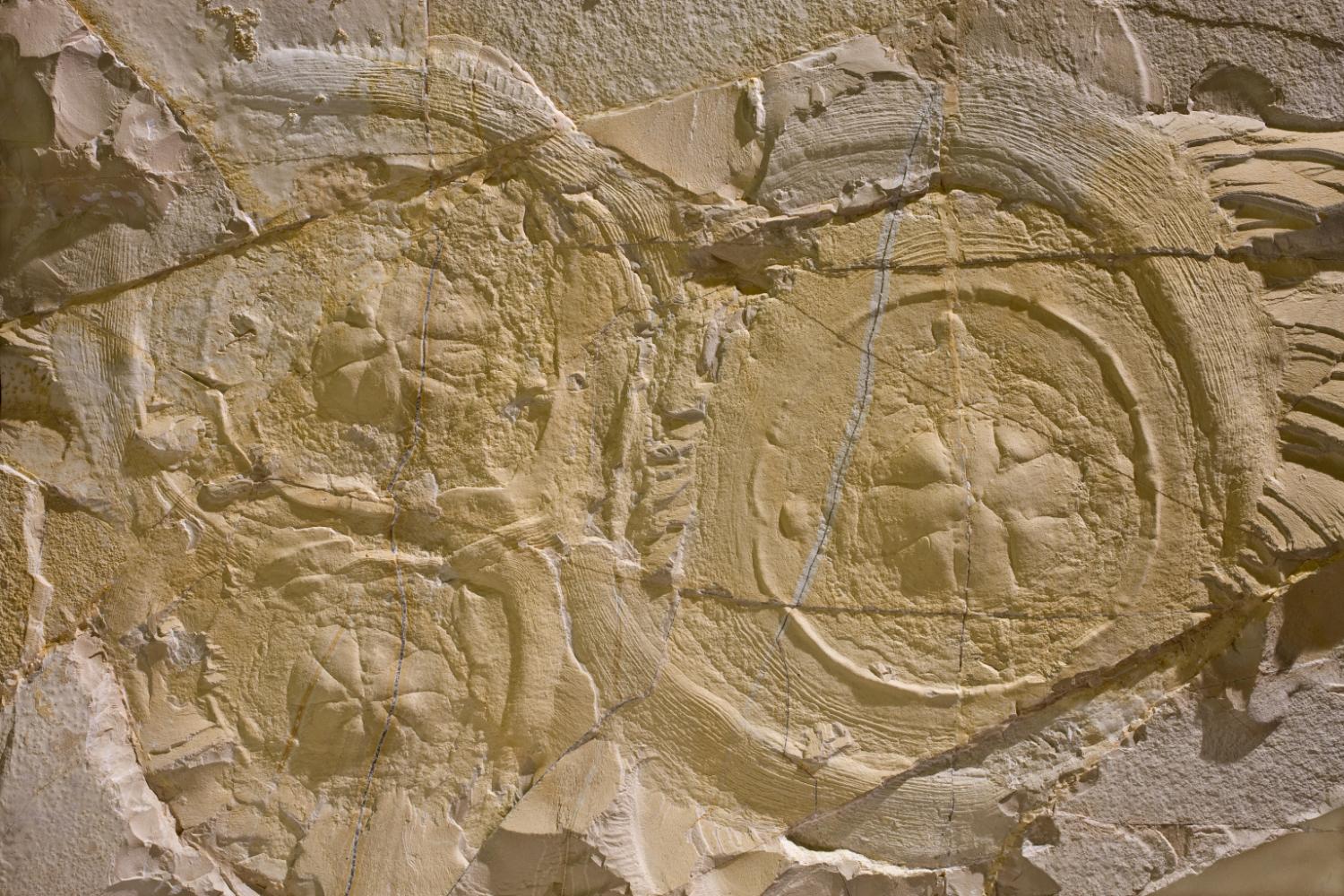The Genesis Flood for kids: Fossils
Published in Creation 45(3):32–35, 2023
In the previous articles, we learned how the Bible teaches about a massive Flood. But many people today reject this history. The Apostle Peter warned of this rejection in 2 Peter 3:3–7:
“scoffers … deliberately overlook this fact … the world that then existed was deluged with water and perished.”
Peter says that these scoffers deliberately overlook the fact of a worldwide flood. This means that the Flood must have left overwhelming evidence, so there is no excuse. This and the following few articles will explain some of this evidence.

How not to form a fossil
Fossils are the remains of dead creatures. As explained in the previous article, many people reject the Flood and believe that rocks and fossils formed gradually. Many museums and textbooks show pictures of how this supposedly happened:
- An animal dies and sinks to the bottom of the sea or lake.
- The soft parts rot or are eaten, leaving the skeleton.
- Sediment layers slowly cover up the skeleton over vast periods of time.
- The layers harden into rock, and the skeleton itself becomes rock.
- Digging or erosion exposes the fossil bones which are then discovered.
But what happens to most fish when they die? You might have seen for yourself that they float. And if left alone, they are eaten. Even if they sink, they don’t last long. Have you been scuba diving near the seafloor and seen all those dead fish fossilizing? Not likely! Even in the deeper ocean, bones dissolve in seawater, and also there are bone-eating worms. When the Titanic wreck was discovered decades after it sank in 1912, no human bones remained. But some shoes and boots were still positioned where their owner’s feet once existed.
Some scientists wanted to see what happened to dead animals in the ocean. So they placed some dead pigs in cages in very cold, deep water off western Canada. They were enclosed in cages to stop big fish from eating the pigs. But in only a week, there was no flesh left. Also, bones are held in place by soft tissue, such as skin, muscles, and ligaments. After the soft tissue disappears, the bones fall apart.

Answer: bury the creature quickly!

The only chance to form a fossil is to bury an animal before scavengers can get to it. And the mud that buries it must contain dissolved minerals ready to turn the remains into rock. Deep burial, with lots of mud, is needed for three main reasons:
- Scavengers might get through a thin layer.
- Scientists tested what happened to small dead crocodiles after underwater burial. When they rotted, the corpses produced gases. These gases caused the body to ‘bloat-and-float’, breaking through the mud layer. Then the body fell apart and was eaten. Only the weight of lots of mud prevented bloat-and-float.
- Rotting corpses produce yucky liquids. These would turn fossils into mush. But mud under high pressure pulls those liquids away from the body before they can do much damage. Of course, the weight of deep layers of burying mud would produce lots of pressure. High pressure also ‘squeeze-dries’ the fossil so it can harden more quickly. Pressure also forces more minerals into the material, eventually turning it into stone.
Under the right conditions, fossils could form in only a day. They don’t need millions of years, as widely believed.
Fast and deep burial by the Flood
A worldwide Flood would form lots of mud and bury many creatures quickly. Many fossils around the world must have been buried quickly, or we would not see them at all. Some good examples:

1. Fossils of creatures giving birth. Ichthyosaurs were sea reptiles that looked a lot like dolphins, which are sea mammals. This one was ‘snap-frozen’ while giving birth. The baby (arrow) has almost finished being born tail-first. This poor creature was certainly not giving birth for millions of years while being slowly buried.

2. Fish in the middle of its lunch. Fish eat very quickly, but this one didn’t even have a chance to finish its meal (another fish, arrow).

3. Fighting dinosaurs from Mongolia. Here, a Velociraptor (right) attacked a Protoceratops (left), then they fought fiercely. Somehow they were buried so quickly in their fighting position that they had no time to break off the fight and flee.

4. ‘Dinosaur death pose’. Many animals with long necks are found with their necks thrown back. How can this be? No animals throw their necks that far back; they could break! These fossils puzzled scientists for many years. But they realized: holding up a heavy head from a distance is hard work. (You try holding a weight with your arm straight out!) So the living animals had a strong elastic cord down the spine to help hold up the neck. After death, the elastic would not have been strong enough to overcome the head’s weight. But underwater, the head could ‘float’, and then the elastic would pull it back. Then loads of mud would bury them in that position.

5. Armoured dinosaurs fossilized upside down.
Living armoured creatures try to avoid being tipped over. But scientists propose that they died in water and then floated. And the armoured back is much heavier than the underside—especially if the dead animal has bloated. So it would not have taken much to tip the floating animal on its back. Then a mudslide would bury it in that position.

6. Fossil jellyfish. Charles Darwin, founder of evolution, claimed, “No organism wholly soft can be preserved.” Of course not—under slow and gradual processes. But these fossils prove Darwin wrong! They must have been buried fast, and their jelly was quickly replaced by minerals and turned into stone. The soft tissue of larger creatures, like skin, brain, etc., has also been found fossilized. Sometimes it is even still soft with intact proteins! How could that be after ‘millions of years’?
Conclusion
The fossils all around the world are a stony record of swift watery burial. This is just what we would expect from a globe-covering Flood. The next two articles will show that the fossils were formed all around the world at about the same time.


Readers’ comments
Comments are automatically closed 14 days after publication.